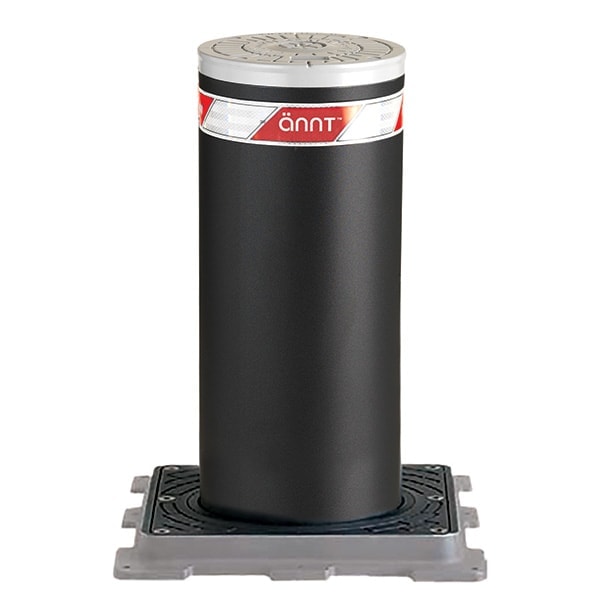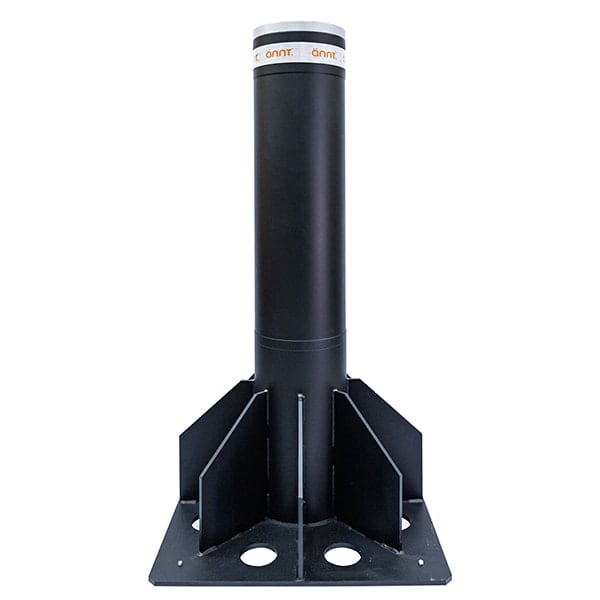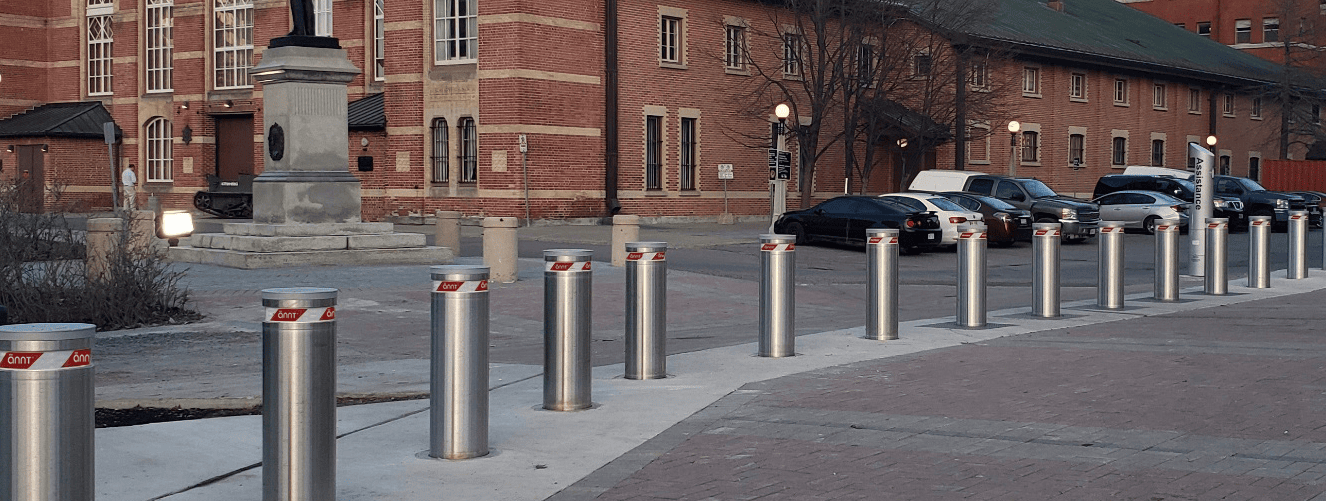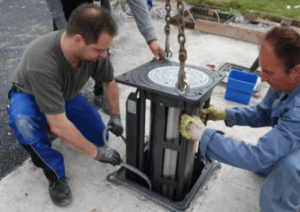Vehicle impact bollards, also called crash rated bollards or security bollards, are strong security barriers designed to keep people and property safe from cars. Unlike decorative or standard bollards that are used for traffic control or aesthetic purposes, vehicle impact bollards are engineered to withstand significant impact from vehicles traveling at high speeds.
These strong barriers are made using heavy-duty materials like steel or reinforced concrete. They are specifically designed to absorb the force of a car crash. Vehicle impact bollards are strategically placed in high-risk areas to prevent unauthorized vehicle access, mitigate potential threats, and safeguard pedestrians, buildings, and critical infrastructure.
The main difference between vehicle impact bollards and decorative or standard bollards are in their ability to withstand car crashes while staying strong. While decorative bollards are mainly used to mark boundaries or look nice, they offer little protection against cars accidentally or intentionally driving into them. Standard bollards, while stronger than decorative ones, are not built to handle the heavy impact of a high-speed car crash.
The Need for Crash Rated Bollards
In today’s world, the threat of car attacks on high-profile targets, such as government buildings, embassies, and public spaces, is a serious problem. These attacks, often carried out by using vehicles as weapons, can cause significant damage and loss of life. Crash rated bollards are an important defense against such threats. They provide a strong physical barrier that can stop a fast-moving vehicle.
The need for crash-rated bollards comes from the rise in car attacks in recent years. Terrorist groups and lone attackers have used cars to cause harm in crowded places and important locations. These attacks show how vulnerable these places are and why we need better security.
Crash-rated bollards are made to pass strict tests, proving they can stop and immobilize a vehicle. These tests give ratings like K-ratings and M-ratings, which are based on crash tests that mimic real-world situations, including the vehicle’s weight, speed, and impact angle. Using bollards with the right ratings helps security professionals reduce the risk of car attacks and protect people and property.
In high-security areas, crash rated bollards are extremely important. They act as a crucial defense, stopping potential attackers and preventing unauthorized vehicles from entering sensitive areas. Whether it’s government buildings, military bases, or public spaces, these bollards provide a reliable solution for improving security and protecting against vehicle threats.
Understanding Crash Ratings
Crash ratings are crucial for assessing how well vehicle impact bollards can protect against car threats. These ratings come from strict tests and give a standard way to measure a bollard’s strength against a vehicle hitting it at a certain speed and weight. The main crash rating systems for vehicle impact bollards are K-ratings and M-ratings.
K-Ratings
K-ratings are set by the United States Department of State to measure how well bollards can handle different vehicle impacts. These ratings go from K4 to K12, with higher numbers showing stronger protection.
– K4: This rating indicates that the bollard can withstand the impact of a 15,000-pound (6,804 kg) vehicle traveling at 30 mph (48 km/h).
– K8: This rating signifies that the bollard can resist the impact of a 15,000-pound (6,804 kg) vehicle traveling at 40 mph (64 km/h).
– K12: This is the highest K-rating, and it means that the bollard can withstand the impact of a 15,000-pound (6,804 kg) vehicle traveling at 50 mph (80 km/h).
M-Ratings
M-ratings are established by the British Standard Institution (BSI) and are used to evaluate the performance of bollards against larger vehicle impacts, typically involving trucks or other heavy vehicles. The ratings range from M30 to M50.
– M30: This rating indicates that the bollard can resist the impact of a 6,800 kg (15,000 lb) truck traveling at 30 mph (48 km/h).
– M50: This is the highest M-rating, and it means that the bollard can withstand the impact of a 6,800 kg (15,000 lb) truck traveling at 50 mph (80 km/h).
Importance of Crash Ratings in Security Planning
Choosing the right crash rating for vehicle impact bollards is vital for the safety and security of high-risk areas. A proper risk assessment and threat analysis should be done to determine the needed level of protection based on the location, potential threats, and types of vehicles that might be used in an attack. By knowing and specifying the correct crash rating, security professionals can ensure that the bollards installed provide the needed protection against vehicle threats, keeping people, property, and critical infrastructure safe.
Applications of Crash-Rated Bollards
Crash-rated bollards are crucial for protecting high-target areas from vehicle attacks. They are commonly used at government buildings, embassies, and military bases. A breach at these locations can have serious consequences, so installing high-security bollards is absolutely necessary.
Commercial properties, like storefronts and parking lots, also benefit from crash-rated bollards. These places often have a lot of people, and a car accident, whether intentional or accidental, could cause major damage, injuries, or even loss of life. By installing bollards with the right crash ratings, businesses can protect their property and create a safer environment for customers and employees.
Public spaces, like pedestrian areas and parks, are also vulnerable to vehicle threats. Since these areas are meant for people on foot, the risk of harm from a car is higher. Crash-rated bollards serve as a strong barrier, stopping unauthorized vehicles from entering and keeping visitors and residents safe.
Whether it’s a government facility, a commercial establishment, or a public gathering space, using crash-rated bollards is essential for reducing the risk of vehicle attacks and protecting lives and property.
Materials and Construction
Vehicle impact bollards are built to endure strong vehicle impacts, so the choice of materials and construction methods is key to their effectiveness. The two most common materials used for crash-rated bollards are steel and concrete.
Steel Bollards: Steel is a popular choice for vehicle impact bollards due to its exceptional strength and durability. These bollards are typically constructed using thick-walled steel pipes or solid steel cylinders, filled with concrete or other reinforcing materials to increase their mass and impact resistance. Steel bollards can be galvanized or coated with a protective finish to prevent corrosion and extend their lifespan.
Concrete Bollards: Concrete is another widely used material for vehicle impact bollards, offering a robust and cost-effective solution. These bollards are typically precast or cast-in-place using high-strength concrete and reinforced with steel rebar or other reinforcement materials. Concrete bollards can be designed with various shapes and sizes to meet specific project requirements.
No matter the material chosen, several design considerations are crucial for maximizing the impact resistance of vehicle impact bollards:
- Depth of Installation: Ensuring the bollard is anchored deep enough into the ground to provide stability.
- Bollard Diameter: A larger diameter can better absorb and distribute impact forces.
- Wall Thickness: Thicker walls enhance the bollard’s strength and durability.
- Reinforcement: Using internal reinforcements, like steel rods in concrete bollards, can increase impact resistance.
- Spacing: Properly spacing bollards ensures they work together to stop a vehicle.
By carefully choosing the right materials and using strong design principles, vehicle impact bollards can offer reliable and effective protection against vehicle threats in high-security areas.
Choosing the Right Bollard
Choosing the right vehicle impact bollard is essential for effective protection against vehicle threats. Several factors need to be considered to ensure the bollard meets the specific security needs of the site.
Threat Level: The first step in choosing the right bollard is to assess the level of threat faced by the location. This involves evaluating factors such as the likelihood of a vehicular attack, the potential impact force, and the desired level of protection. High-risk areas, such as government buildings, military installations, or high-profile commercial properties, may require bollards with higher crash ratings, such as K12 or M50.
Location and Environment: The location and surrounding environment also play a crucial role in bollard selection. Factors such as pedestrian traffic, vehicle access requirements, and aesthetic considerations should be taken into account. In some cases, removable or retractable bollards may be more suitable to allow authorized vehicle access while maintaining security.
Budget: While security is paramount, budget constraints are often a reality. It’s essential to strike a balance between the desired level of protection and the available financial resources. Working with experienced security professionals can help identify cost-effective solutions that meet both security and budgetary requirements.
Importance of Professional Consultation: Choosing the right vehicle impact bollard is a complex process that requires expertise and careful consideration. Consulting with security professionals, engineers, and experienced bollard manufacturers is crucial to ensure the selected solution meets all necessary safety and performance standards. These experts can provide valuable guidance, conduct site assessments, and recommend the most appropriate bollard system based on the specific needs of the location.
By taking into account the threat level, location, budget, and seeking professional consultation, organizations can ensure they implement an effective and reliable vehicle impact bollard system, providing the necessary protection against potential vehicular threats while meeting their unique security requirements.
Regulations and Compliance
Relevant Codes and Standards
The primary standards governing vehicle impact bollards are set by the American Society for Testing and Materials (ASTM). The ASTM F2656/F2656M-20 standard provides specifications for the design, testing, and performance of vehicle impact bollards. It defines the crash test conditions, rating systems, and acceptance criteria for different levels of protection.
Other relevant standards include:
– ASTM F3016/F3016M-14: Standard Test Method for Surrogate Vehicle Penetration Testing of Vehicle Security Barriers
– PAS 68: Impact test specifications for vehicle security barrier systems (UK standard)
– IWA 14-1: Vehicle security barriers (International standard)
Compliance with these standards ensures that the bollards can withstand specified impact forces and provide the desired level of protection against vehicular threats.
Certification Requirements
Vehicle impact bollards must undergo rigorous testing and certification processes to verify their performance and compliance with applicable standards. Manufacturers typically obtain third-party certifications from accredited testing facilities to validate their product’s crash ratings.
Common certification requirements include:
1. Crash Testing: Bollards are subjected to controlled vehicle impact tests at various speeds and angles, using certified test vehicles. The performance is evaluated based on factors such as penetration distance, debris dispersion, and structural integrity.
2. Material Testing: The materials used in the construction of the bollards, such as steel or concrete, are tested for their strength, durability, and resistance to environmental factors.
3. Quality Control: Manufacturers must maintain strict quality control measures during production to ensure consistency and adherence to certified designs and specifications.
4. Documentation: Detailed documentation, including engineering drawings, calculations, and test reports, must be provided to demonstrate compliance with the relevant standards.
Specifiers and security professionals should always request certified products from reputable manufacturers and verify the appropriate certifications for their specific project requirements. Compliance with regulations and standards is essential to ensure the effectiveness and reliability of vehicle impact bollards in protecting high-risk areas from vehicular threats.
Protecting high-target areas from vehicular attacks is a critical concern in today’s security landscape. Vehicle impact bollards, especially those with crash ratings like K-ratings and M-ratings, provide a strong and effective solution for mitigating these threats. Throughout this article, we have explored the importance of these specialized bollards, their applications, materials, choosing the right bollards and real-world examples
Choosing the right vehicle impact bollard for your specific security needs is crucial. Factors such as the level of risk, site conditions, and compliance requirements should guide your selection process. By partnering with experienced security experts and following best practices, you can ensure the optimal implementation of these vital security barriers.
To take the next step in securing your premises, we invite you to contact our team for a consultation or request a quote tailored to your unique requirements. Additionally, we offer a comprehensive guide on crash-rated bollards, which you can read for further insights.
Prioritize the safety of your personnel, assets, and visitors by investing in vehicle impact bollards – a proven defense against vehicular threats.






